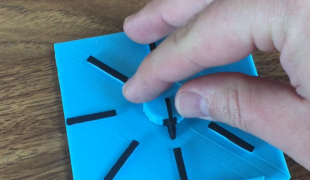- 7312
- 443
- 14
- 10
- 0
- Help Ukraine
About the solution
Heidi Hertel is a mother of 3. When her oldest daughter was 3-years-old, her school teacher found something unusual with her eyes which, after a visit to the eye doctor, turned out to be a serious eye condition called Strabismus. And, after taking her middle daughter for a checkup, they found that she would also need to wear glasses.
However, the following years os shopping for glasses proved to be very challenging and frustrating. “It was a constant battle to find glasses that checked boxes for everything we needed; namely ones that fit properly in a cute style and color.”, she explains. The high prices and the concern that the glasses would brake easily, as well as the fact that children quickly outgrow their glasses, were also a source of frustrating.
So, Heidi decided to launch her own business by creating Fitz Frames, a company that uses 3D printing technology to create durable, affordable and perfectly fitted glasses. The glasses are purchased online through the Fitz Frames app. The app uses the smartphone’s camera to provide an Augmented Reality experience in which the child can virtual try on the glasses and see what they look like in their face. They can change the design and color and try as many frames as they want in order to choose their favorite. Then, ensure a perfect fit, the app ask the user to take a series of photos from which it takes accurate measurements of the face.
Other than the perfect fit, another unique feature that is the potential for personalization, as Fitz Frames’ founder explains: “We can print glasses custom to each individual’s unique features, in the color and style that suit them. And we are able to offer personalization inside the frame, so kids can include their name, lucky number, etc. to make getting the glasses experience feel a little more special.”
To make the frames more durable, instead of the typical metal hinges with screws, Fitz Frames uses snap-fit hinges. This system means that the frames are designed to come apart and be easily snapped back together instead of breaking.
Heidi really believes that this new approach to children’s glasses can have a positive impact in kids and their families: ““By letting them see what they look like in our virtual try on, encouraging them to pick a name or phrase to be printed inside, we eliminate the stress that comes with highly priced glasses you typically find in stores and online. For parents, we’ve made it a convenient process as you can shop and receive the glasses at home, slipping multiple store visits. And you can’t overestimate the benefit of seeing your child want to wear their glasses.”
More information: https://www.fitzframes.com/
Adapted from:
https://smallbiztrends.com/2020/01/3d-printed-glasses-business-fitz-fram...
https://www.ptonline.com/blog/post/these-3d-printed-glasses-are-designed...
https://www.jennikayne.com/ripandtan/heidi-hertel-fitz-frames-interview
这些解决方案不应包括使用药物,化学品或生物制品(包括食品);创伤性设备;冒犯性的,商业或内在危险的内容。该解决方案未经医学验证。请谨慎进行!如果您有任何疑问,请咨询健康专家。
DISCLAIMER: This story was written by someone who is not the author of the solution, therefore please be advised that, although it was written with the utmost respect for the innovation and the innovator, there can be some incorrect statements. If you find any errors please contact the patient Innovation team via info@patient-innovation.com
-
-
395
-
0
-
6110

Parents bring together experts to create smart glasses for their son suffering from low vision
COMMUNICATION: Communicating, whether by speaking, listening, or other means
CAREGIVING
WALKING: Walking
Urban exploration
Tunnel Vision
5 Senses support devices: (glasses, hearing aids, headphones...)
Assistive Daily Life Device (to help ADL)
Vision problems
Regaining sensory function
Promoting self-management
Preventing (Vaccination, Protection, Falls, Research/Mapping)
Caregiving Support
Neurology
Ophthalmology
Pediatrics
Spain
-
-
-
669
-
1
-
10556

Parents create 3D printed orthosis inspired by their son
CAREGIVING
MOVING IN A WHEELCHAIR: Moving using a wheelchair.
(SELF)-CARE: EATING: Eating independently.
(SELF)-CARE: DRINKING: Drinking independently.
Cerebral Palsy
Angelman's Syndrome
Neuromuscular Disorders
Muscle Tone Abnormalities weakness
3d Printed
Assistive Daily Life Device (to help ADL)
Body-Worn solutions (Clothing, accessories, shoes, sensors...)
Prosthesis
Gait abnormalities (e.g., walking difficulties, unsteady gait)
Muscle cramps or spasms
Difficulty coordinating movements
Stiffness or rigidity (difficulty moving)
Paralysis of the legs and lower body
Muscle weakness
Loss of balance
Managing Neurological Disorders
Maintaining Balance and Mobility
Caregiving Support
Neurology
Pediatrics
United Kingdom
-
-
-
357
-
0
-
5059

Tactile VoiceOver Rotor Box
-
 zh
zh